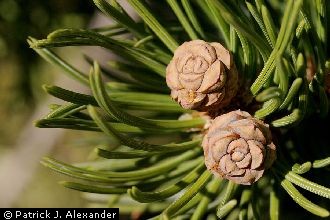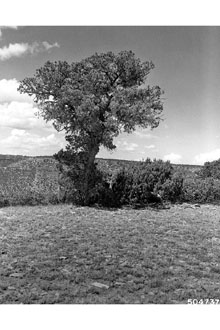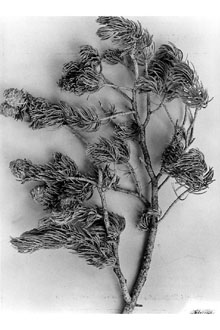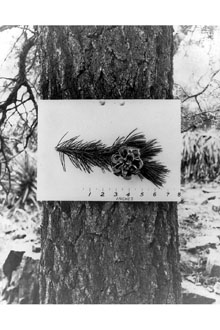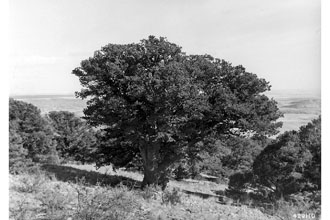Twoneedle Pinyon
Scientific Name: Pinus edulis Engelm.
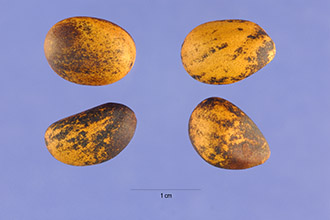
| General Information | |
|---|---|
| Usda Symbol | PIED |
| Group | Gymnosperm |
| Life Cycle | Perennial |
| Growth Habits | Tree |
| Native Locations | PIED |
Plant Guide
Alternate Names
Pinyon, common pinyon, New Mexico pinyon, Colorado pinyon, mesa pinyon, two-leaf pinyon, nut pine, twoneedle pinyon. Spanish spellings are piñon and piñón.
Uses
The edible nuts of pinyon and are in demand because of their delicate flavor and are probably the most commercially valuable product of the species, Pinyon ranks first among the native nut trees that are not also cultivated, The nuts are commonly sold and eaten after roasting in the shell, but small quantities are sold raw, They were once a staple food of Southwestern Indians, Local residents now harvest quantities for the local and gourmet market, but they are in competition with many wild animals that also seek the nuts as food, Pinyon nuts are a preferred food for turkeys, pinyon jays, woodrats, bears, and other wildlife, and they are a common food for deer, particularly during harsh winters with deep snows, Pinyon-juniper woodlands provide habitat for a varied wildlife population, including mule deer, white-tailed deer, elk, desert cottontail, mountain cottontail, and wild turkey, © James Manhart Vascular Plant Image Gallery Texas A&M Univ,, Bioinformatics Working Group Poor growth form and small size of two-needle pinyon has limited its use for sawn products, Specialized woodworking shops use the wood for novelties, and small sawmills produce mine timbers and railroad ties, Two-needle pinyon has been used for pulping in the Southwest, but only to alleviate shortages of normally used mill-residue chips and pulpwood of other species, It has been widely used for fuel since the pitchy wood has a higher heat value than any of its associates except the oaks and burns with a pleasing aroma, It is also occasionally processed for charcoal, Pinyons have been cut for private and commercial use for Christmas trees, These beautiful little trees are slow growing but should be more widely used for ornamental purposes, Two-needle pinyon is the state tree of New Mexico, , Use soil moisture sensors to measure the soil moisture of Twoneedle Pinyon.
Status
Please consult the PLANTS Web site and your State Department of Natural Resources for this plant’s current status, such as, state noxious status and wetland indicator values.
Description
General: Pine Family (Pinaceae). Native shrubs or trees growing 5-12(-21) meters tall, with a strongly tapering trunk, single-stemmed and tallest at higher elevations, multi-stemmed, bushy and sprawling on lower sites, the crown usually compact, rounded and spreading. Bark is reddish-brown, shallowly and irregularly furrowed. Needles are evergreen, 2 per bundle, less commonly 1 or 3, 2-4 cm long, upcurved, yellow-green to blue-green, mostly 2-3-sided, all surfaces with pale stomatal bands, the margins smooth or finely toothed. Seed cones about (3.5) 4(5) cm long at maturity, ovoid before opening, depressed-ovoid to nearly globose when open, short-stalked to nearly sessile. Seeds mostly ellipsoid to obovoid 10-15 mm long, light brown, wingless. The seeds rest in a deep depression on each cone scale and a flap of tissue holds them in place, so the seeds are readily available to birds. The common name represents a species of pinyon pine producing two needles per bundle. The Spanish “piñon” refers to the large seed (pine in Spanish is “pino”). Variation within the species: the California outlier of two-needle pinyon has been considered a distinct species, California Pine (Pinus californiarum) (Bailey 1987), or a population of 2-needled trees of single-leaf pinyon (Pinus monophylla var. californiarum). Pinus edulis var. fallax is seen by some to combine features of P. edulis and P. monophylla – but it has most recently been treated as part of other species (P. californiarum subsp. fallax; P. monophylla var. fallax). The differences in opinion regarding these species of pinyon pine are further reflected in the observation that even the typical form of P. edulis has been treated as a variety of both P. monophylla and P. cembroides. Naturally occurring hybrids have been reported between two-needle pinyon and single-leaf pinyon in several areas.
Distribution
Southwestern United States, in southern California (rare), the intermountain region (Wyoming, Utah, Colorado, Arizona, New Mexico), to western Oklahoma (rare) and western Texas, and south into Chihuahua, Mexico. For current distribution, please consult the Plant Profile page for this species on the PLANTS Web site.
Establishment
Adaptation: Dry mountain slopes, mesas, plateaus, growing scattered in open woodlands at 1200-2450 (-2700) meters elevation, in pure stands, or commonly mixed with one or more of several species of juniper. Two-needle pinyon is one of the most slow-growing and drought-resistant species of pines, requiring only 12-18 inches of rainfall a year, but it grows best on the higher, wetter sites, just below the zone of ponderosa pine. Planting: Trees may begin producing cones when 25 years of age but produce significant quantities of seed only after reaching 75-100 years old. Good seed crops occur every 4 to 7 years (on average) or more frequently on better sites, and cone bearing tends to be synchronous over large geographical areas. Germination is generally above 80%. A relationship of mutual benefit exists between two-needle pinyon and four species of corvid birds: Clark’s nutcracker, Steller’s jay, scrub jay, and pinyon jay. These birds are the primary agents of dispersal of this pine, which provides a large portion of their diet and subsistence, but only the scrub jay and pinyon jay cache seeds in the pinyon-juniper zone and are responsible for its regeneration. Seed germination and establishment of the two-needle pinyon are best in the shade of trees or shrubs and probably depend on an adequate moisture supply during the first summer. Growth through all stages is extremely slow. Dominant trees in a stand are often 400 years old, and individuals 800-1000 years old have been found.
Management
Grazing pressure by sheep and goats greatly reduces the regenerative capacity of the two-needle pinyon, and huge areas of pinyon-juniper woodlands have been extensively cattle-grazed. Range improvement practices to increase forage for wildlife and livestock have removed the trees over large areas. Woodland watersheds also have been mechanically cleared or chemically treated in the past, but future treatments may be limited to specific areas, because the possibility of generally increasing water yield does not appear promising. Compared to pinyon pines, junipers have deeper root penetration and drought resistance and will dominate regeneration for up to 70 years after severe disturbance at a site. If small junipers and pines survive a less severe disturbance, the site may be naturally reforested after 2-3 decades. Cultivars, Improved and Selected Materials (and area of origin) These plant materials are readily available from commercial sources. Contact your local Natural Resources Conservation Service (formerly Soil Conservation Service) office for more information. Look in the phone book under ”United States Government.” The Natural Resources
Conservation
Service will be listed under the subheading “Department of Agriculture.”
References
Bailey, D.K. 1987. A study of Pinus subsection Cembroides 1: The single-needle pinyons of the Californias and the Great Basin. Notes Roy. Bot. Gard. Edinburgh 44(2):275-310. Kral, R. 1993. Pinus. Pp. 373-398, IN: Flora of North America, north of Mexico. Vol. 2, Pteridophytes and Gymnosperms. Oxford Univ. Press, New York. <http://hua.huh.harvard.edu/cgi-bin/Flora/flora.pl?FLORA_ID=12395> Ronco, F.P., Jr. 1990. Pinus edulis. Pp. 327-337, IN: R.M. Burns and B.H. Honkala. Silvics of North America. Volume 1. Conifers. USDA Forest Service Agric. Handbook 654, Washington, D.C. <http://willow.ncfes.umn.edu/silvics_manual/Table_of_contents.htm>
Plant Traits
Growth Requirements
| Temperature, Minimum (°F) | -31 |
|---|---|
| Adapted to Coarse Textured Soils | Yes |
| Adapted to Fine Textured Soils | Yes |
| Adapted to Medium Textured Soils | Yes |
| Anaerobic Tolerance | None |
| CaCO3 Tolerance | Low |
| Cold Stratification Required | Yes |
| Drought Tolerance | High |
| Fertility Requirement | Medium |
| Fire Tolerance | Low |
| Frost Free Days, Minimum | 200 |
| Hedge Tolerance | None |
| Moisture Use | Low |
| pH, Maximum | 8.5 |
| pH, Minimum | 6.5 |
| Planting Density per Acre, Maxim | 600 |
| Planting Density per Acre, Minim | 170 |
| Precipitation, Maximum | 27 |
| Precipitation, Minimum | 9 |
| Root Depth, Minimum (inches) | 20 |
| Salinity Tolerance | Medium |
| Shade Tolerance | Intolerant |
Morphology/Physiology
| Bloat | None |
|---|---|
| Toxicity | None |
| Resprout Ability | No |
| Shape and Orientation | Conical |
| Active Growth Period | Spring and Summer |
| C:N Ratio | High |
| Coppice Potential | No |
| Fall Conspicuous | No |
| Fire Resistant | No |
| Flower Color | Yellow |
| Flower Conspicuous | No |
| Foliage Color | Green |
| Foliage Porosity Summer | Moderate |
| Foliage Porosity Winter | Moderate |
| Foliage Texture | Medium |
| Fruit/Seed Conspicuous | No |
| Nitrogen Fixation | None |
| Low Growing Grass | No |
| Lifespan | Long |
| Leaf Retention | Yes |
| Known Allelopath | Yes |
| Height, Mature (feet) | 50.0 |
| Height at 20 Years, Maximum (fee | 25 |
| Growth Rate | Slow |
| Growth Form | Single Stem |
| Fruit/Seed Color | Brown |
Reproduction
| Vegetative Spread Rate | None |
|---|---|
| Small Grain | No |
| Seedling Vigor | Low |
| Seed Spread Rate | Slow |
| Seed per Pound | 2333 |
| Fruit/Seed Persistence | No |
| Propagated by Tubers | No |
| Propagated by Sprigs | No |
| Propagated by Sod | No |
| Propagated by Seed | Yes |
| Propagated by Corm | No |
| Propagated by Cuttings | No |
| Bloom Period | Early Summer |
| Commercial Availability | Routinely Available |
| Fruit/Seed Abundance | High |
| Fruit/Seed Period Begin | Summer |
| Fruit/Seed Period End | Fall |
| Propagated by Bare Root | Yes |
| Propagated by Bulb | No |
| Propagated by Container | Yes |
Suitability/Use
| Veneer Product | No |
|---|---|
| Pulpwood Product | No |
| Protein Potential | Low |
| Post Product | Yes |
| Palatable Human | Yes |
| Palatable Graze Animal | Low |
| Palatable Browse Animal | Low |
| Nursery Stock Product | Yes |
| Naval Store Product | No |
| Lumber Product | No |
| Fuelwood Product | High |
| Fodder Product | No |
| Christmas Tree Product | Yes |
| Berry/Nut/Seed Product | Yes |

